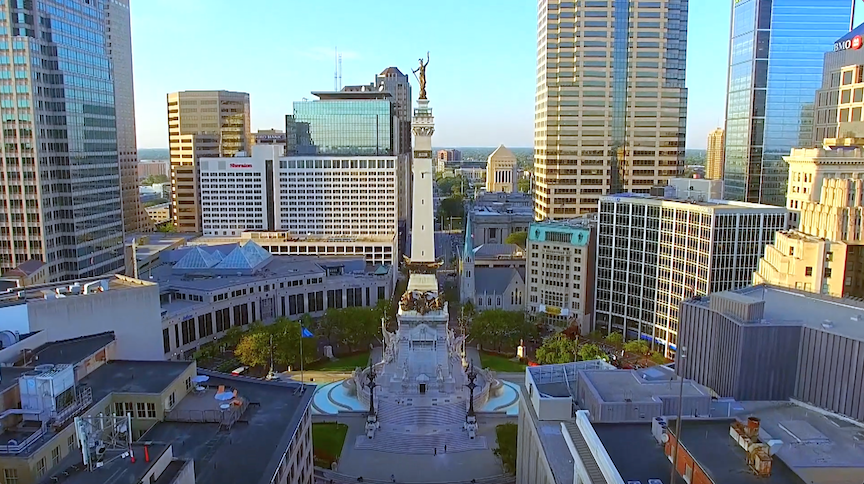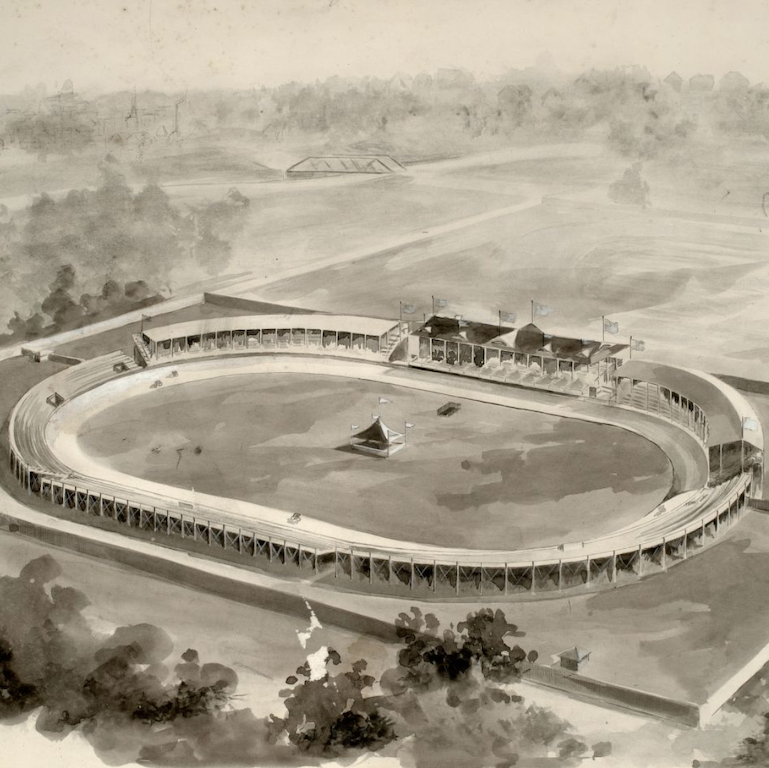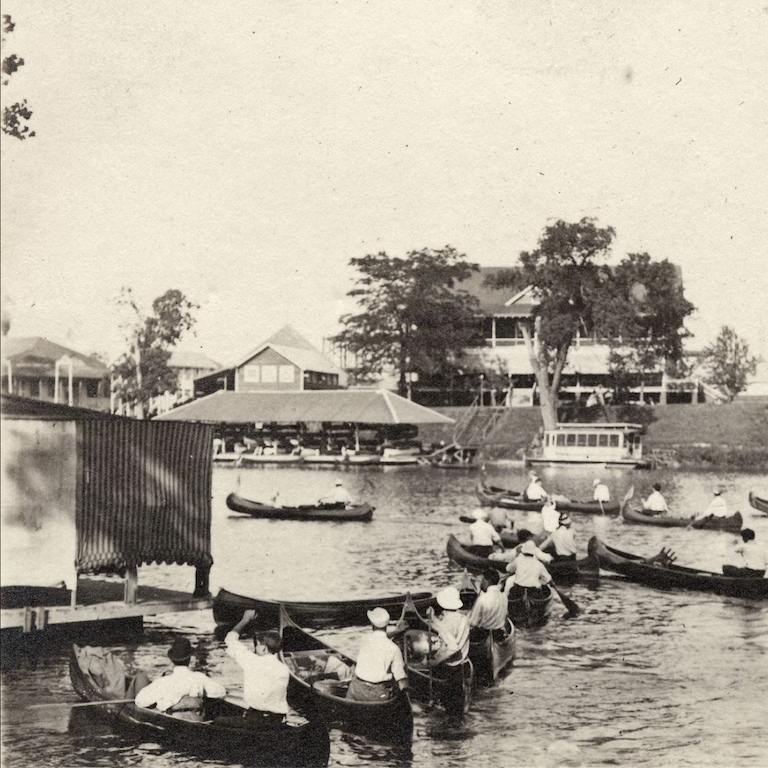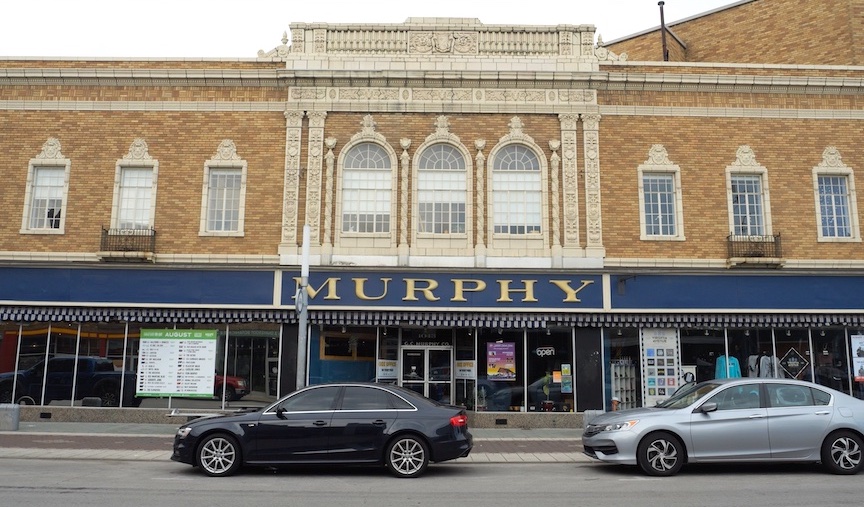Jyoti is an Indianapolis native who’s lived in the region for her entire life. She’s currently the Assistant Managing Editor of the Digital Encyclopedia of Indianapolis, where she identifies new content and recruits, trains, and supports writers of said material. When she’s not working, Jyoti can be found competing in marathons and triathlons and then refueling in one of the many restaurants around Indianapolis.
Touring the Past: 8 Fun Facts About Indianapolis History

Photo courtesy of Visit Indy
I’ve lived in Indianapolis my entire life, bouncing from the eastside Avondale-Meadows neighborhood to the northwest side near Lafayette Square Mall. The three IPS schools I attended were within biking distance of my childhood home—and so were countless restaurants, specialty stores, the mall, and the Eagle Branch of the Indianapolis Public Library.
I ended up leaving the 465 loop for a few years. But now, I’m back inside the heart of Indianapolis on the city’s northside! Once again, I can walk to local restaurants, bike to the grocery store, explore the sites at Broad Ripple, and see the beautiful neighborhoods in Nora.
The places I lived were in the city suburb, but I’ve always loved visiting downtown Indianapolis. As a kid, we’d go down to City Market for specialty fruits and veggies or stop by L.S. Ayres and the Block department store to see the holiday decorations. In my twenties, I hung out at Union Station when it was THE place to be, and I watched the Colts and Pacers play in their original venues—the Hoosier Dome and Market Square Arena.
I may be carbon dating myself here, but let me tell you something. Indianapolis has a rich history of important people, places, and events that shaped this city! Even after decades, I never tire of living here, and that’s because I’ve seen how our community has grown over the years.
For all the history buffs out there, you can still explore some of the city’s most historic sites. Simply grab a bike and ride along on this tour of Indianapolis history!
1. Downtown Mile Square
One of the reasons I love Indianapolis is because it’s easy to navigate, using a convenient and straightforward grid system. With only a few diagonal exceptions, all the roads around downtown meet in simple, four-way intersections that make it easy to explore the city block by block.
We can thank architect Alexander Ralston for that! He helped design the nation’s capital back in 1781, and he brought all of those architectural concepts to Indianapolis. Anyone who’s been to Washington D.C. will notice the similarities.
Like D.C., Indianapolis also has a central rotunda around Monument Circle with four radiating avenues: Massachusetts, Virginia, Kentucky, and Indiana. Each of these roads bisects a quadrant of the Mile Square, which is bounded by East, West, North, and South Street!
Another interesting fact about downtown is that the roads east of Meridian Street are named after eastern states, while those west of Meridian are named for western states. The only streets without state names are Meridian and Market Street, Circle Street, and Washington Street—which was technically named for President Washington as part of the National Road U.S. 40.
So, next time you’re in Indianapolis, keep an eye out for the street signs! Our city planners put a lot of thought into creating a system that’s simple, efficient, and elegant.
2. Taggart Baking Company
Want to see the greatest thing since sliced bread? That’s right! The legendary Wonder Bread was originally manufactured right here in downtown Indianapolis.
If you stroll through the northeast quadrant of the Mile Square, you’ll find 18 North New Jersey Street—the old location of The Taggart Baking Company. The bakery first opened back in 1869, but it wasn’t until 1921 that they launched Wonder Bread.
Back then, Wonder Bread was one of the first to sell pre-sliced, pre-wrapped bread across the nation. Their loaves lined grocery store shelves all across the country, and they remain a grocery staple to this day, over a century later. In fact, Taggart Baking Company is so important that the History Channel dedicated an episode of The Food that Built America to Wonder Bread!

Photo courtesy of the Indiana Historical Society

Photo courtesy of the Indiana Historical Society
3. Newby Oval
If you love bike riding like I do, I suggest you go for a ride up Illinois Street’s bike lanes and then veer on Fall Creek Parkway to where the Newby Oval once sat. The Newby Oval was a quarter-mile wooden track built for bicycle racing back in 1898.
The oval took its name from Arthur Newby, a local businessman and cycling enthusiast. In the 1890s, cycling was becoming a popular pastime, and Indianapolis embraced the new craze. So, Newby and other cyclists in the city decided to build a track at Central Avenue and 31st Street.
At the time, the Newby Oval was one of the fastest tracks in the United States with state-of-the-art electric lighting to accommodate night competitions. Looking back, it’s hard to believe, but the stadium sat more than 8,000 spectators!
People came from all across the country to watch prominent cyclists compete, including Indianapolis native Marshall “Major” Taylor. The track also hosted automobile races until Newby, James Allison, Carl Fisher, and Frank Wheeler established the Indianapolis Motor Speedway. As the popularity of auto racing increased, the Oval was eventually demolished in 1902. However, the site was honored with a Historical Marker on July 24, 2021.
4. George F. Cram Company
As you come back downtown to East Georgia Street, you’ll pass what used to be the old George F. Cram Company. They opened up shop in Indianapolis back in 1921 and thrived there for decades.
Do you remember the name Cram? Think back to your elementary school classroom filled with globes, atlases, and Mercator maps to help teach geography. Those all came from the Cram Company, which started in Chicago in 1867 before moving to Indy.
The Cram Company was a leading globe and map manufacturer for nearly a century, and schools accounted for 80% of Cram’s production. They sold large wall maps for classroom-use primarily in the U.S. and Canada, but their globes were sold worldwide—all from Indianapolis!
Eventually, the company was sold to Herff Jones in 2005, and they discontinued making Cram products in 2012. But still, who hasn’t seen a globe? And to think that Indianapolis was the center of the industry for over 100 years! That’s something to be proud of.
5. Murphy Art Center
From Georgia Street, you’re only a quick bike ride away from the heart of Fountain Square on the Cultural Trail. Down at 1043 Virginia Avenue, you’ll find the old Murphy Building built back in 1884. The Murphy Building was named after the G.C. Murphy Store that used to be there in the 1950s.
The G.C. Murphy Store was a chain of discount shops across the country. In 1951, they combined several buildings in Indianapolis to make a large shopping complex for the now-defunct variety store. I don’t know if Cram sold their products there, but they definitely offered a variety of deals that would only cost you a nickel or a dime.
Today, the Murphy Building is home to the Murphy Art Center—a unique shopping space with 27 regular tenants. It has art galleries, artist studios, the HI-FI concert venue, and two restaurants: La Margarita and the Red Lion Grog House. Check out their First Friday events every month, where artists let you roam their galleries, grab food and drinks, and purchase some art of your own.
6. Magdalene Laundries
Around the southern edge of downtown near the Eli Lilly campus, you’ll pass where the Magdalene Laundries used to be. This wasn’t a typical laundromat where you wash your clothes. No, these “laundries” became the first-known prisons for women and girls who committed “moral crimes,” like prostitution, adultery, or out-of-wedlock pregnancies.
The term “laundry” referred to how religious orders would try to metaphorically wash away the sins of these women, sentencing them to work at the convent. It’s certainly not the most glamorous part of our history, but the Magdalene Laundries are still an important part of our past. The Indianapolis Convent of the Good Shepherd opened at 111 W. Raymond Street back in 1873, and the Sisters’ laundry remained open until 1955.
What amazes me is that we only recently rediscovered this history. In 2017, former inmate at the Indiana State Women’s Prison, Michelle Jones, uncovered the story behind the laundry while researching the prison’s background. This discovery simply proves that there’s always something new to learn about our city—and the lessons from our past.
7. Dust Bowl Tournaments
If you travel a few miles north on Indiana Avenue, you’ll find the site of the old Lockefield Gardens neighborhood complex. Lockefield Gardens was a Public Works Administration project and the first federally funded housing development in the country. This new neighborhood replaced dilapidated buildings with low-rent housing for Indy’s African American community.
In 1938, the Police Athletic Club sponsored a basketball league for the young Black boys growing up in the neighborhood. Ten years later, the local league grew into an event called the Dust Bowl Tournament. The original Dust Bowl was a dirt court made of cinder and gravel, bookended by two backboards with net-less rims. Although it was paved by the time of the first tournament in 1948, the name stuck—with players boasting that they played so hard, the grass turned to dust.
The Dust Bowl was a famous proving ground for young basketball players, challenging them to up their game. In fact, rising stars like Willie Gardner, Haillie Bryant, and Oscar Robertson all got their start playing ball here! Gardner and Bryant eventually played for the Harlem Globetrotters, while Robertson went on to play for the Milwaukee Bucks!
Today, Indiana Black Expo continues the Dust Bowl Tournament tradition during its Summer Solstice Celebration. And in February 2016, a Historical Marker was placed at the corner of the IUPUI campus to recognize the site of the original Dust Bowl Tournament.
8. Taggart Riverside Park
From Indiana Avenue, I like to use a combination of the Cultural Trail and White River Wapahani Trail to get to the northwest corner of downtown. And guess where we are now? Surprise! It’s the Taggart Riverside Park in the beautiful Riverside Park neighborhood.
Now, this isn’t the same Taggart from Wonder Bread. (That was Alexander Taggart!) This park is named after Thomas Taggart, the Mayor of Indianapolis from 1895 to 1904. But it only seemed fitting that I bring you full circle back to the familiar surname from the start of this tour!
Riverside Park was the place to be 100 years ago. Our zoo was there until the 1940s, and we even had an amusement park à la Kings Island until 1970. Think roller coasters, a carousel, a skating rink, and a beach with a six-story diving tower!
The amusement park may be gone now, but Riverside Park is still a lively place. You should check out the summer concert series at the Taggart Memorial Amphitheatre, as well as eclectic events like Indy Shakes’ hip-hop version of Richard III. They offer shows and concerts for all age-groups and tastes!

Explore Hoosier history one landmark at a time!
Most of these historic places are long gone, leaving only memories and legacies behind. But we can still learn a lot from visiting these landmarks and remembering the stories from our past! Indianapolis wouldn’t be the vibrant, innovative city it is today without the leaders, entrepreneurs, and creators that shaped our history.
These eight landmarks are just a handful of the historic places I like to visit, but you can find relics of Hoosier history just about everywhere you go! Indianapolis is home to highly renowned museums, including the Eiteljorg Museum, the Indiana State Museum, and the Indianapolis Motor Speedway Museum. You can also visit Conner Prairie or the Indiana Historical Society for immersive exhibits that recreate important voices and historic moments.
We also have the Encyclopedia of Indianapolis—an awesome digital resource with all the people, places, and organizations that built our city and help shape our future.
But I think the best way to learn about a place is exploring the city in person! That’s why I wanted to put together this tour guide and show you some of my favorite spots around Indianapolis. Simply hop on your bike—or rent one from the Pacers Bikeshare—and explore our history for yourself!


